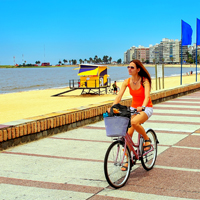Public Transportation in Montevideo
Summary: Learning how to get around using public transportation in Montevideo is an important step in adjusting to life in Montevideo. In this article, we cover the local public transportation options.
Montevideo, the capital city of Uruguay, is a bustling metropolis with a well-developed public transportation system. The city offers a variety of public transportation options including buses, taxis, and cycling paths. The bus system, run by the Montevideo City Council, is the most widely used form of public transportation in the city. Taxis are also a popular choice, especially for short distances or for those who prefer a more private mode of transportation. For the environmentally conscious, the city also boasts an extensive network of cycling paths. With these options, an expat living in Montevideo could comfortably live without a car, relying on the public transportation system and walking.
Buses
The bus system in Montevideo is extensive and efficient, covering almost every corner of the city. It is safe to use at any time of the day, making it a reliable mode of transportation for everyone, including women traveling alone and children going to school. The cost of a bus ticket is approximately 38 Uruguayan pesos (around 1 USD), making it an affordable option for daily commuting. The routes are well-planned, ensuring that you can reach any part of the city using the bus system. However, it's worth noting that the buses can get crowded during peak hours, so it's advisable to plan your travel accordingly.
Taxis
Taxis in Montevideo are another popular mode of transportation. They are safe, reliable, and can be easily hailed from the street or booked through a mobile app. The fares are metered and relatively affordable, although they are more expensive than buses. A typical taxi ride within the city center would cost around 200 Uruguayan pesos (approximately 5 USD). Taxis are a good option for those who prefer a more private and comfortable mode of transportation, or for those who are traveling with a lot of luggage.
Cycling
For those who prefer a more active mode of transportation, Montevideo offers an extensive network of cycling paths. The city has made a significant effort to promote cycling as a sustainable mode of transportation, and it's not uncommon to see locals and expats alike cycling to work or for leisure. The city also has a public bike-sharing program called Movete, which allows users to rent bikes for a small fee. The cycling paths are safe and well-maintained, making cycling a viable option for daily commuting.
In conclusion, Montevideo's public transportation system is well-developed and efficient, making it possible for expats to live comfortably without a car. Whether you prefer the affordability and extensive coverage of the bus system, the convenience and privacy of taxis, or the sustainability and active lifestyle promoted by cycling, Montevideo has got you covered.
About the Author
 Joshua Wood, LPC joined Expat Exchange in 2000 and serves as one of its Co-Presidents. He is also one of the Founders of Digital Nomad Exchange. Prior to Expat Exchange, Joshua worked for NBC Cable (MSNBC and CNBC
Primetime). Joshua has a BA from Syracuse and a Master's in Clinical and Counseling Psychology from Fairleigh Dickinson University. Mr. Wood is also a licensed counselor and psychotherapist.
Joshua Wood, LPC joined Expat Exchange in 2000 and serves as one of its Co-Presidents. He is also one of the Founders of Digital Nomad Exchange. Prior to Expat Exchange, Joshua worked for NBC Cable (MSNBC and CNBC
Primetime). Joshua has a BA from Syracuse and a Master's in Clinical and Counseling Psychology from Fairleigh Dickinson University. Mr. Wood is also a licensed counselor and psychotherapist.
Some of Joshua's articles include Pros and Cons of Living in Portugal, 10 Best Places to Live in Ireland and Pros and Cons of Living in Uruguay. Connect with Joshua on LinkedIn.
Additional Information:
- Public Transportation in Montevideo
- Best Neighborhoods for Single Digital Nomads Living in Montevideo
- Pros & Cons of Living in Montevideo
- Best International Schools and Bilingual Schools in Montevideo
- 7 Weekend Getaways for Digital Nomads Living in Montevideo
- Best Bookstores and Libraries in Montevideo
- Fun Classes for Expats Living in Montevideo
- Public Transportation in Montevideo
- Best Markets in Montevideo
- Retire in Montevideo Guide
- 7 Tips for Living in Montevideo
- Pros & Cons of Living in Montevideo
- Driving in Montevideo
- Health Care in Montevideo
- Discover the Best of Montevideo
- Cost of Living in Montevideo
- Healthcare & Health Insurance in Uruguay
- Best Places to Live in Uruguay
- Real Estate in Uruguay
- Enrolling in the Public Healthcare System in Uruguay
- Pros and Cons of Living in Uruguay 2025
- 2025 Guide to Moving to Uruguay




